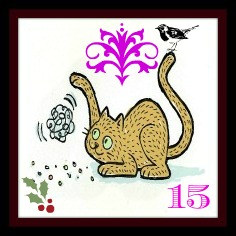Two
of the favorite techniques I use in my work
are wire knit and wire
crochet. People often ask
me why I have different names for them because
they know that I use a crochet hook for both
techniques. There's an old post here where I
started to explain the difference, but then I
thought it might be interesting for you to if I dig
a little deeper.
First of all let me say that there's no official term
that
everyone uses. What I call wire knit, might be
called wire crochet by
others, or invisible spool
knitting.
I took some pictures of basic samples for you to
hopefully clear the confusion up a bit.
Even though it might be hard to believe ... ALL of
these samples started
out with eight chain stitches
and ALL of them were worked on with the same
size crochet hook – and the same fingers.
So what exactly is it that makes them look so
differently from each other?
Let's start with the flat piece. The first difference
you might notice is what I like to call "open
stitches". They make a piece much easier to
unravel, that can be a good thing ... and it can be
very bad if a cat tries to run off with your wire
(which is not something I ever encourage).
As you can see, the wire knit sample has all open
stitches while the wire crochet only has one open
stitch at the
end. Again, open stitches can be good
if you found a mistake you want to fix,
but more
often it is not something you want. This goes for
all shapes of
wire knit or crochet, you will see that
in the next pictures. Of course
it is nothing you get
to see in a finished piece, so that fact is
interesting,
but no help in identifying a technique.
|
|
The other thing you can see is that the wire knit
sample has a much more open, airy structure.
Compared to it the other sample is tighter and a
bit smaller, too.
Why is that?
In wire knit you put your hook through a stitch,
grab the wire
with it and make a loop. That's it.
You move on to the next stitch, grab the wire,
make a loop, to the next, and so on.
In wire crochet however you put your hook
through the stitch with the last made stitch still
on your hook and
grab the wire. Now you have
two loops and you grab the wire once more
with
your hook and pull it through both of them.
So there is more wire in crochet pieces, which
makes them less
slinky and delicate looking
than knit pieces.
They also can't be pulled as easily as knit pieces
which again can be both an advantage and a
disadvantage. On the other hand it makes
them
sturdier and the stitch pattern is maybe more
interesting.
Next I will show you two rope or tube samples.
Wire ropes offer
endless possibilities and I love
to play around with them to make new
designs.
Again you can see how much more open the wire
knit sample looks. I
deliberately took the
pictures on reflective underground to point that
out even more. It makes this technique perfect for
filling beads into a
tube. The beads are not hidden
as much as in a crochet tube where we know
more
wire is involved. Also the beads help
maintaining the shape of the knit
rope because
they don't just look delicate, they really are. A
crochet rope
withstands pressure from outside
a lot better. I wouldn't recommend wire
knit ropes
around children for example, or you might end up
with a
flattened rope which is not that easy to
re-shape if possible at all, or you suddenly have
a slimmer, but much longer necklace which is
something that can't be changed back at all.
|
|
Last, but not least I'll share the disk with you
which is often the base for making bezels for rocks,
beads or cabochons.
Thanks to being so flexible a wire knit disk can be
shaped
beautifully around a stone, even the free
form ones. I have also used
it for rings, earrings
and pendants, with or without beads.
The crochet disk is sturdier and
therefore harder
to use on irregularly shaped stones, but works
great
for rounds or ovals. I have also used it as
focal for necklaces or
earrings.
Of course I know I have only scratched the
surface with this, but I still hope that has helped a
bit for the beginning.
|
|





































